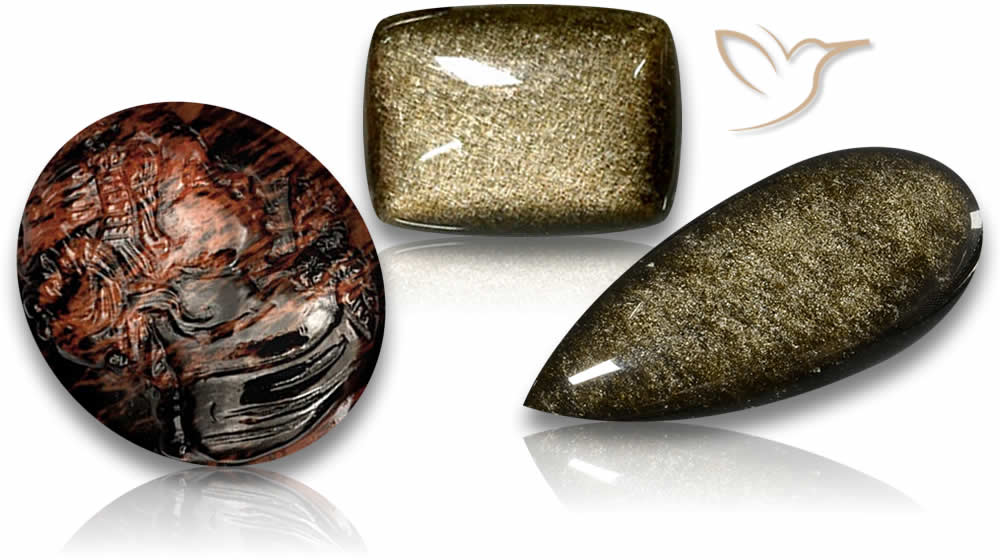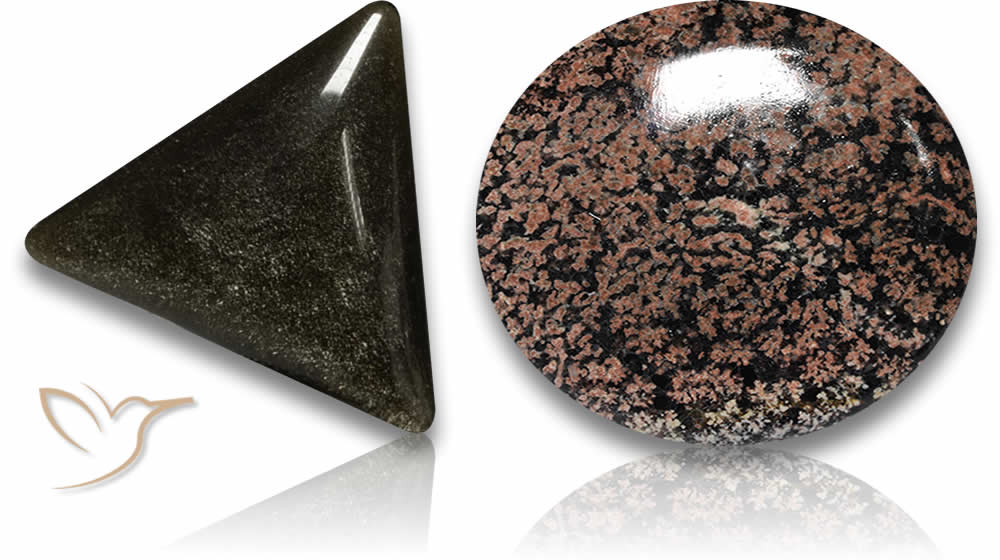Unlock the Mysteries of Obsidian – Discover More

Obsidian is a striking and mysterious gemstone formed from rapidly cooled lava, creating a natural volcanic glass with a smooth, reflective surface. Known for its deep black color, Obsidian gemstone can also appear in shades of brown, green, or even with unique patterns like snowflakes or rainbow-like iridescence. Throughout history, Obsidian has been revered for its sharpness, durability, and mystical qualities, often used for tools, weapons, and spiritual purposes.
In this article, we will explore the fascinating origins, properties, and uses of Obsidian, shedding light on why this ancient gemstone continues to captivate both gem enthusiasts and collectors around the world.
Feel free to browse our selection of natural Obsidian Gemstones for sale.
Key Takeaways:
- Obsidian is a unique form of volcanic glass prized for its beauty and practical uses.
- Through exploring the geological processes and ancient civilizations that valued it, we can unlock the mysteries of obsidian.
- The stunning array of colors and clarity of obsidian, combined with its transparency and luster, make it a sought-after gemstone.
- Obsidian can be cut and shaped to enhance its beauty, and there are various treatments that can be used to achieve the desired effect.
- By unearthing the sources of obsidian and gaining inspiration for jewelry designs, we can appreciate the value and unique qualities of this captivating gemstone.
Unveiling the Origins of Obsidian
Obsidian, a volcanic glass formed through the rapid cooling of lava, has a unique composition that sets it apart from other gemstones. Unlike crystalline minerals, obsidian has a non-crystalline and amorphous structure, making it a fascinating subject of geology and mineralogy.
The history of obsidian dates back to ancient civilizations such as the Egyptians, who used it for small ornamental objects and weapons. It was also significant for Mesoamerican cultures, particularly the Aztecs, who used it extensively for tools and weapons, and even in sacrificial ceremonies.
Obsidian's remarkable properties have made it a highly valued material in various industries, from medicine to aerospace. In medicine, ultra-sharp obsidian blades are used for delicate surgeries, while in aerospace, its thermal shock resistance makes it ideal for heat shields.
Overall, the origins and uses of obsidian are as intriguing as the gemstone itself, and this volcanic glass continues to fascinate people from all walks of life.
The Beauty of Obsidian Colors and Clarity
Obsidian's alluring appearance is characterized by its stunning array of colors and clarity. The color of obsidian ranges from dark brown to black, and sometimes even green or red, adding to its beauty. Its coloration is derived from the presence of iron and magnesium in the lava from which it is formed.
Obsidian's unique transparency and luster contribute to its appeal as a gemstone. The mineral is characterized by a glass-like texture and often reflects light in a striking manner, enhancing the beauty of the gemstone. The clarity of obsidian can sometimes range from opaque to translucent.
The obsidian color, clarity and luster can be attributed to its rapid cooling rate from hot, flowing lava. When lava cools quickly, it solidifies into obsidian without the formation of crystals, resulting in its smooth, glassy finish.
Overall, obsidian's color and clarity make it a popular choice for jewelry, as its unique beauty captures the attention of many gemstone enthusiasts.
The Art of Cutting and Shaping Obsidian
Obsidian's unique physical qualities require careful cutting and shaping to enhance its natural beauty. Techniques such as faceting, cabochon cutting, and carving are used by skilled artisans to reveal the gemstone's intricate patterns and colors.
Obsidian's conchoidal fracture can make it difficult to work with, but skilled craftsmen can shape it into various forms with precision. There are several cutting and polishing techniques that are used to bring out the best in obsidian. The type of cut used can significantly affect the way the light refracts within the gemstone, leading to different hues and patterns.
Obsidian is not usually treated or enhanced in any way.
Unearthing Sources of Obsidian
Obsidian is a unique gemstone formed from volcanic glass that can be found in many parts of the world. Here are some of the major obsidian mining locations that produce high-quality specimens:
| Location | Obsidian Type |
|---|---|
| Oregon, United States | Mahogany, Rainbow, Snowflake |
| Peru | Black, Silver Sheen |
| Mexico | Apache Tear, Black |
| Italy | Green, Black, Brown |
| Turkey | Black, Mahogany, Snowflake |
Obsidian has been used for centuries by various cultures for toolmaking, jewelry, and even currency. Each mining location produces unique variants, so it's worth exploring different sources to discover the vast and beautiful variety of obsidian types.
Unleashing Creative Ideas for Obsidian Jewelry Design
Obsidian’s beauty and unique properties make it an excellent choice for creating stunning jewelry pieces. Whether you prefer bold, statement pieces or delicate, understated ones, obsidian can be incorporated into any design. Here are some creative ideas to inspire your obsidian jewelry-making:
1. Simple Earrings
Obsidian’s striking black color makes it a perfect choice for simple, yet elegant earrings. Pair it with gold or silver hardware for a timeless look. For added interest, try incorporating different shapes or textures into the design.
2. Geometric Pendants
If you prefer bolder pieces, try incorporating geometric shapes into your obsidian jewelry. Triangles, circles and hexagons are all excellent choices for pendants or statement necklaces. Obsidian’s smooth, reflective surface will contrast beautifully with sharp, angular shapes.

3. Layered Bracelets
For a modern, trendy look, try layering multiple obsidian stone bracelets. Pair it with delicate gold chains or add a pop of color with brightly colored beads. You can also mix and match different shapes and sizes for added interest.
4. Wire-wrapped Rings
Obsidian’s rich, dark color looks particularly stunning when set in wire-wrapped rings. Experiment with different wire colors and thicknesses to achieve the look you desire. Obsidian’s smooth surface ensures that it won't catch or snag on clothing or other jewelry.
As with any gemstone jewelry, it’s essential to take care of your obsidian pieces properly. Avoid exposing them to harsh chemicals, such as bleach or perfume, as they may damage or even discolor the stone. Instead, try cleaning them with a soft, lint-free cloth and warm, soapy water.
Investing in high-quality obsidian jewelry is a smart choice for those seeking unique, durable pieces that can be worn for years to come. With a little creativity and proper care, your obsidian jewelry collection can become a timeless addition to your wardrobe.
Conclusion
As we conclude our journey through the world of obsidian, we cannot ignore its value and significance. Obsidian is a truly unique gemstone that stands out for its beauty, durability, and metaphysical properties.
When it comes to obsidian price, it is relatively affordable compared to other black gems such as black diamonds or black sapphires. However, the price can vary based on factors such as the rarity of the color, size, and cut.
Obsidian is also renowned for its healing powers. It is believed to have a grounding and protective effect, shielding the wearer from negative energies and promoting balance and harmony. Many people also use obsidian for spiritual exploration and inner healing.
Compared to other black gems, obsidian holds its own as a unique and alluring option. Its natural luster and clarity make it an excellent choice for jewelry designers looking to create distinctive pieces that stand out.
Overall, we hope this article has increased your appreciation for the mysteries of obsidian. Whether you are a gemstone enthusiast, jewelry designer, or just curious about this fascinating volcanic glass, obsidian offers something truly special that is worth exploring.
FAQ
What is obsidian?
Obsidian is a type of volcanic glass that forms when molten lava rapidly cools. It is composed primarily of silica and has a smooth, glassy appearance.
What is the history of obsidian?
Obsidian has a rich history dating back thousands of years. It was highly prized by ancient civilizations such as the Mayans, Aztecs, and ancient Egyptians for its use in tools, weapons, and religious ceremonies.
What colors does obsidian come in?
Obsidian can come in a variety of colors, including black, brown, gray, and even red or green. The most common color, however, is black.
How clear and lustrous is obsidian?
Obsidian can have a high degree of clarity and luster, especially when it is cut and polished correctly. Its translucency and shine make it a popular choice for jewelry.
How is obsidian cut and shaped?
Obsidian can be cut and shaped using lapidary techniques such as cabochon cutting, faceting, and carving. Skilled artisans can bring out the unique beauty and patterns in each piece of obsidian.
Are there any treatments applied to obsidian?
While obsidian does not usually require any treatments, some varieties may undergo heat treatment or enhancement to intensify or alter their colors.
What is the hardness rating of obsidian?
Obsidian is relatively soft with a typical hardness of 5 to 5.5 on the mineral hardness scale.
Where is obsidian mined?
Obsidian is found in various locations worldwide. Major mining locations include Mexico, Iceland, the United States (in places like California and Oregon), Peru, and Turkey.
What design ideas can be used for obsidian jewelry?
There are endless design possibilities for obsidian jewelry. It can be used in necklaces, bracelets, earrings, and rings, showcasing its natural beauty. From minimalist to elaborate designs, obsidian adds a touch of elegance to any jewelry piece.
How do I care for my obsidian jewelry?
To care for your obsidian jewelry, simply clean it with a soft, damp cloth and avoid exposing it to harsh chemicals or excessive heat. Store it in a jewelry box or pouch to prevent scratching or damage.
What is the price range of obsidian gemstones?
The price of obsidian can vary depending on factors such as color, clarity, and size. Generally, obsidian is relatively affordable compared to other gemstones, making it accessible to a wide range of jewelry enthusiasts.
What are the healing powers of obsidian?
Obsidian is believed to have various metaphysical properties, including grounding, protection against negativity, and promoting emotional healing. It is often used during meditation and energy healing practices.
How does obsidian compare to other black gems?
Obsidian differs from other black gemstones such as black onyx or black spinel in terms of its volcanic origin and unique appearance. Its natural glassy shine and vibrant colors set it apart, making it an exquisite choice for jewelry designers and collectors.

